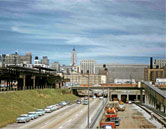History

Eisenhower Expressway looking east from Peoria Street, June 14, 1958. (Photo by George Krambles, courtesy of the Krambles-Peterson Archive)
In 1940, the City Council of Chicago established the Westside Route, or Congress Expressway, as their first priority in a comprehensive superhighway system. The work on Congress was expected to begin quickly since the war was over, but skyrocketing costs, limited funding, extensive utility relocation, poor subsurface conditions, and the need for agreements with three railroads, municipalities and a cemetery all added time and cost to the project schedule. Construction would also have to accommodate the CTA Congress Line in the median and the temporary relocation of the Douglas Park CTA line. As a result, the first section of the expressway was not completed until December 1954.
Within the I-290 project study area, construction of individual sections was completed between 1954 and 1960, making the section from Mannheim Rd. (US12/20/45) to Racine Avenue one of the oldest sections of the region's highway infrastructure. The Congress Parkway, or Eisenhower Expressway, is the only expressway to run under the U.S. Post Office and have a moveable bridge over the Chicago River. It was also the first expressway in the United States to incorporate a rapid transit line and an expressway within the same corridor.
Serving as the western gateway to the city of Chicago and the Chicago Central Area, I-290 is a major link in the transportation network serving northeast Illinois. This section of I-290 is the primary corridor connecting commuters between the western suburbs and the City of Chicago Loop, as well as connecting commuters from south Cook County to the high employment centers found in the I-88 Technology Corridor and the O'Hare International Airport commerce centers.
